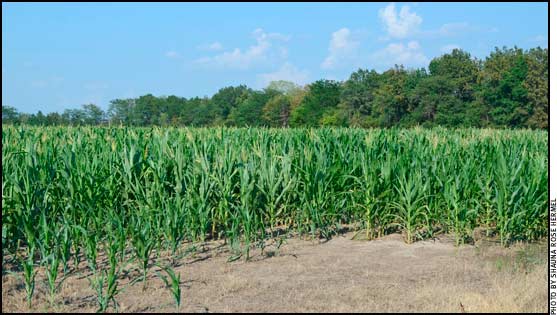
Watch Aflatoxin Levels
Livestock producers should be aware of aflatoxin in corn grain, silage.
Heat and drought over the summer months created an ideal environment for Aspergillus ear rot to form in corn grain and silage. The disease is caused by a fungus that may produce aflatoxin, which can be harmful to livestock.
"Aflatoxin can be very toxic and carcinogenic," said Donna Amaral-Phillips, University of Kentucky College of Agriculture dairy specialist. "The Food and Drug Administration (FDA) limits the amount of aflatoxin allowable in lactating dairy cow feed to 20 parts per billion (ppb) and 0.5 parts per billion in milk. These amounts are lower than what is allowed in diets of breeding beef cattle." Table 1 lists the FDA action levels for aflatoxins in animal feeds.
| Table 1: FDA action levels for aflatoxins in animal feeds |
|
| 20 ppb | For corn and other grains intended for immature animals (including immature poultry) and for dairy animals, or when its destination is not known |
| 20 ppb | For animal feeds, other than corn or cottonseed meal |
| 100 ppb | For corn and other grains intended for breeding beef cattle, breeding swine, or mature poultry |
| 200 ppb | For corn and other grains intended for finishing swine of 100 pounds or greater |
| 300 ppb | For corn and other grains intended for finishing (i.e., feedlot) beef cattle and for cottonseed meal intended for beef cattle, swine or poultry |
"Aspergillus ear rot is a fungal disease resulting in olive-green, powdery mold, generally on the tip of the ear, but it may be located all the way to the base," said Paul Vincelli, UK extension plant pathologist. "It is caused by Aspergillus flavus, and it can produce aflatoxin, but it doesn't always do so. The pathogen tends to attach to kernels when temperatures are between 80° and 100° Fahrenheit, in high humidity and high nighttime temperatures during grain fill and pollination."
Aspergillus flavus gets under the husks by growing on the yellow-brown silks.
If growers have seen mold growing on ears of corn, it doesn't necessarily indicate alfatoxin is present. Aflatoxin is only one of the hundreds of mycotoxins mold produces.
"Researchers who study Aspergillus ear rot report that kernel development is needed for the growth of Aspergillus mold," said Chad Lee, UK extension grain crops specialist. "Thus, in corn plants which did not pollinate — harvested as corn silage without ears — the risk for aflatoxin appears to be low."
Lee recommends that producers should scout for this disease prior to harvesting grain or silage to assess the possibility of potential aflatoxin problems. For more information on detecting this mold, please refer to the UK Grain Crops Update, "Scouting Corn for Aspergillus Ear Rot," available at http://graincrops.blogspot.com/2012/09/scouting-corn-for-aspergillus-ear-rot.html.
For more information on aflatoxin, click here to download USDA's Aflatoxin Handbook.Vincelli and Lee said tests are available for detecting aflatoxin in grain crops; however, they are costly and require proper conditions and accurate sampling.
"We recommend scouting fields ahead of harvest, but if you've already harvested, you may want to test for aflatoxin in well-eared silage," Lee said. "You have to realize you are testing for very low quantities of aflatoxin, and that aflatoxin may not be uniform across the field. When sampling, you may or may not sample the location where the aflatoxin is present. Unfortunately, there are no good solutions here."
Producers should also be aware that distillers' grains or corn-gluten feed can contain even higher levels of aflatoxin than the corn grain from which they originated.
Kentucky and some other states have received approval for corn high in aflatoxin to be mixed with other corn to obtain an aflatoxin content safe for feeding to specific animals (see sidebar).
UK Division of Regulatory Services director Darrell Johnson emphasized, however, that does not make it appropriate for all livestock.
"Producers should understand that they cannot feed the blended product to dairy animals or young swine and beef cattle," he said. "If you buy the blended product, you'll have to sign a statement from the seller that you will not feed it to those animals."
When purchasing blended corn grain, producers should follow the directions in the precautionary statements accompanying the load if they plan to use it in rations for older beef cattle, swine or poultry.
Editor's Note: This article is adapted from an article provided by the University of Kentucky College of Agriculture.
[Click here to go to the top of the page.]












